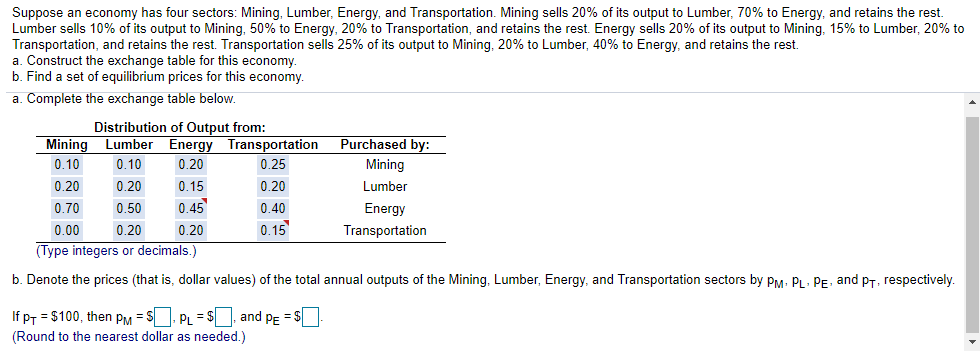ppose an economy has four sectors: Mining, Lumber, Energy, and Transportation. Mining sells 20% of its output to Lumber, 70% to Energy, and retains the rest. mber sells 10% of its output to Mining, 50% to Energy, 20% to Transportation, and retains the rest. Energy sells 20% of its output to Mining, 15% to Lumber, 20% to ansportation, and retains the rest. Transportation sells 25% of its output to Mining, 20% to Lumber, 40% to Energy, and retains the rest. Construct the exchange table for this economy. Find a set of equilibrium prices for this economy. Complete the exchange table below. Distribution of Output from: Mining Lumber Energy Transportation Purchased by: 0.10 0.10 0.20 0.25 Mining 0.20 0.20 0.15 0.20 Lumber 0.70 0.50 0.45 0.40 Energy
ppose an economy has four sectors: Mining, Lumber, Energy, and Transportation. Mining sells 20% of its output to Lumber, 70% to Energy, and retains the rest. mber sells 10% of its output to Mining, 50% to Energy, 20% to Transportation, and retains the rest. Energy sells 20% of its output to Mining, 15% to Lumber, 20% to ansportation, and retains the rest. Transportation sells 25% of its output to Mining, 20% to Lumber, 40% to Energy, and retains the rest. Construct the exchange table for this economy. Find a set of equilibrium prices for this economy. Complete the exchange table below. Distribution of Output from: Mining Lumber Energy Transportation Purchased by: 0.10 0.10 0.20 0.25 Mining 0.20 0.20 0.15 0.20 Lumber 0.70 0.50 0.45 0.40 Energy
Linear Algebra: A Modern Introduction
4th Edition
ISBN:9781285463247
Author:David Poole
Publisher:David Poole
Chapter2: Systems Of Linear Equations
Section2.4: Applications
Problem 28EQ
Related questions
Topic Video
Question

Transcribed Image Text:Suppose an economy has four sectors: Mining, Lumber, Energy, and Transportation. Mining sells 20% of its output to Lumber, 70% to Energy, and retains the rest.
Lumber sells 10% of its output to Mining, 50% to Energy, 20% to Transportation, and retains the rest. Energy sells 20% of its output to Mining, 15% to Lumber, 20% to
Transportation, and retains the rest. Transportation sells 25% of its output to Mining, 20% to Lumber, 40% to Energy, and retains the rest.
a. Construct the exchange table for this economy.
b. Find a set of equilibrium prices for this economy.
a. Complete the exchange table below.
Distribution of Output from:
Mining Lumber Energy Transportation
Purchased by:
0.10
0.10
0.20
0.25
Mining
0.20
0.20
0.15
0.20
Lumber
0.45
Energy
0.70
0.50
0.40
0.15
Transportation
0.00
0.20
0.20
(Type integers or decimals.)
b. Denote the prices (that is, dollar values) of the total annual outputs of the Mining, Lumber, Energy, and Transportation sectors by pM: PL- PE, and pr, respectively.
If pr = $100, then PM = S |. PL = S , and Pe = S
(Round to the nearest dollar as needed.)
Expert Solution
This question has been solved!
Explore an expertly crafted, step-by-step solution for a thorough understanding of key concepts.
This is a popular solution!
Trending now
This is a popular solution!
Step by step
Solved in 4 steps with 3 images

Knowledge Booster
Learn more about
Need a deep-dive on the concept behind this application? Look no further. Learn more about this topic, algebra and related others by exploring similar questions and additional content below.Recommended textbooks for you

Linear Algebra: A Modern Introduction
Algebra
ISBN:
9781285463247
Author:
David Poole
Publisher:
Cengage Learning

Linear Algebra: A Modern Introduction
Algebra
ISBN:
9781285463247
Author:
David Poole
Publisher:
Cengage Learning